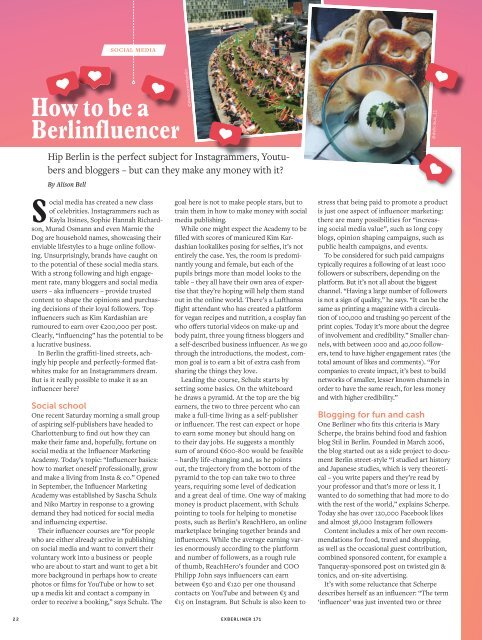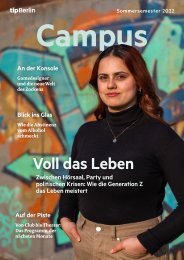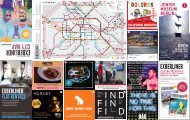Create successful ePaper yourself
Turn your PDF publications into a flip-book with our unique Google optimized e-Paper software.
DON’T WORK, MAKE MONEY<br />
SOCIAL MEDIA<br />
@awesomenberlin<br />
How to be a<br />
Berlinfluencer<br />
Hip Berlin is the perfect subject for Instagrammers, bers and bloggers – but can they make any money with<br />
Youtu-<br />
it?<br />
By Alison Bell<br />
@delicieux_11<br />
Social media has created a new class<br />
of celebrities. Instagrammers such as<br />
Kayla Itsines, Sophie Hannah Richardson,<br />
Murad Osmann and even Marnie the<br />
Dog are household names, showcasing their<br />
enviable lifestyles to a huge online following.<br />
Unsurprisingly, brands have caught on<br />
to the potential of these social media stars.<br />
With a strong following and high engagement<br />
rate, many bloggers and social media<br />
users – aka influencers – provide trusted<br />
content to shape the opinions and purchasing<br />
decisions of their loyal followers. Top<br />
influencers such as Kim Kardashian are<br />
rumoured to earn over €200,000 per post.<br />
Clearly, “influencing” has the potential to be<br />
a lucrative business.<br />
In Berlin the graffiti-lined streets, achingly<br />
hip people and perfectly-formed flatwhites<br />
make for an Instagrammers dream.<br />
But is it really possible to make it as an<br />
influencer here?<br />
Social school<br />
One recent Saturday morning a small group<br />
of aspiring self-publishers have headed to<br />
Charlottenburg to find out how they can<br />
make their fame and, hopefully, fortune on<br />
social media at the Influencer Marketing<br />
Academy. Today’s topic: “Influencer basics:<br />
how to market oneself professionally, grow<br />
and make a living from Insta & co.” Opened<br />
in September, the Influencer Marketing<br />
Academy was established by Sascha Schulz<br />
and Niko Martzy in response to a growing<br />
demand they had noticed for social media<br />
and influencing expertise.<br />
Their influencer courses are “for people<br />
who are either already active in publishing<br />
on social media and want to convert their<br />
voluntary work into a business or people<br />
who are about to start and want to get a bit<br />
more background in perhaps how to create<br />
photos or films for YouTube or how to set<br />
up a media kit and contact a company in<br />
order to receive a booking,” says Schulz. The<br />
goal here is not to make people stars, but to<br />
train them in how to make money with social<br />
media publishing.<br />
While one might expect the Academy to be<br />
filled with scores of manicured Kim Kardashian<br />
lookalikes posing for selfies, it’s not<br />
entirely the case. Yes, the room is predominantly<br />
young and female, but each of the<br />
pupils brings more than model looks to the<br />
table – they all have their own area of expertise<br />
that they’re hoping will help them stand<br />
out in the online world. There’s a Lufthansa<br />
flight attendant who has created a platform<br />
for vegan recipes and nutrition, a cosplay fan<br />
who offers tutorial videos on make-up and<br />
body paint, three young fitness bloggers and<br />
a self-described business influencer. As we go<br />
through the introductions, the modest, common<br />
goal is to earn a bit of extra cash from<br />
sharing the things they love.<br />
Leading the course, Schulz starts by<br />
setting some basics. On the whiteboard<br />
he draws a pyramid. At the top are the big<br />
earners, the two to three percent who can<br />
make a full-time living as a self-publisher<br />
or influencer. The rest can expect or hope<br />
to earn some money but should hang on<br />
to their day jobs. He suggests a monthly<br />
sum of around €600-800 would be feasible<br />
– hardly life-changing and, as he points<br />
out, the trajectory from the bottom of the<br />
pyramid to the top can take two to three<br />
years, requiring some level of dedication<br />
and a great deal of time. One way of making<br />
money is product placement, with Schulz<br />
pointing to tools for helping to monetise<br />
posts, such as Berlin’s ReachHero, an online<br />
marketplace bringing together brands and<br />
influencers. While the average earning varies<br />
enormously according to the platform<br />
and number of followers, as a rough rule<br />
of thumb, ReachHero’s founder and COO<br />
Philipp John says influencers can earn<br />
between €50 and €120 per one thousand<br />
contacts on YouTube and between €5 and<br />
€15 on Instagram. But Schulz is also keen to<br />
stress that being paid to promote a product<br />
is just one aspect of influencer marketing:<br />
there are many possibilities for “increasing<br />
social media value”, such as long copy<br />
blogs, opinion shaping campaigns, such as<br />
public health campaigns, and events.<br />
To be considered for such paid campaigns<br />
typically requires a following of at least 1000<br />
followers or subscribers, depending on the<br />
platform. But it’s not all about the biggest<br />
channel. “Having a large number of followers<br />
is not a sign of quality,” he says. “It can be the<br />
same as printing a magazine with a circulation<br />
of 100,000 and trashing 90 percent of the<br />
print copies. Today it’s more about the degree<br />
of involvement and credibility.” Smaller channels,<br />
with between 1000 and 40,000 followers,<br />
tend to have higher engagement rates (the<br />
total amount of likes and comments). “For<br />
companies to create impact, it’s best to build<br />
networks of smaller, lesser known channels in<br />
order to have the same reach, for less money<br />
and with higher credibility.”<br />
Blogging for fun and cash<br />
One Berliner who fits this criteria is Mary<br />
Scherpe, the brains behind food and fashion<br />
blog Stil in Berlin. Founded in March 2006,<br />
the blog started out as a side project to document<br />
Berlin street-style “I studied art history<br />
and Japanese studies, which is very theoretical<br />
– you write papers and they’re read by<br />
your professor and that’s more or less it. I<br />
wanted to do something that had more to do<br />
with the rest of the world,” explains Scherpe.<br />
Today she has over 120,000 Facebook likes<br />
and almost 38,000 Instagram followers<br />
Content includes a mix of her own recommendations<br />
for food, travel and shopping,<br />
as well as the occasional guest contribution,<br />
combined sponsored content, for example a<br />
Tanqueray-sponsored post on twisted gin &<br />
tonics, and on-site advertising.<br />
It’s with some reluctance that Scherpe<br />
describes herself as an influencer: “The term<br />
‘influencer’ was just invented two or three<br />
22<br />
EXBERLINER <strong>171</strong>

















